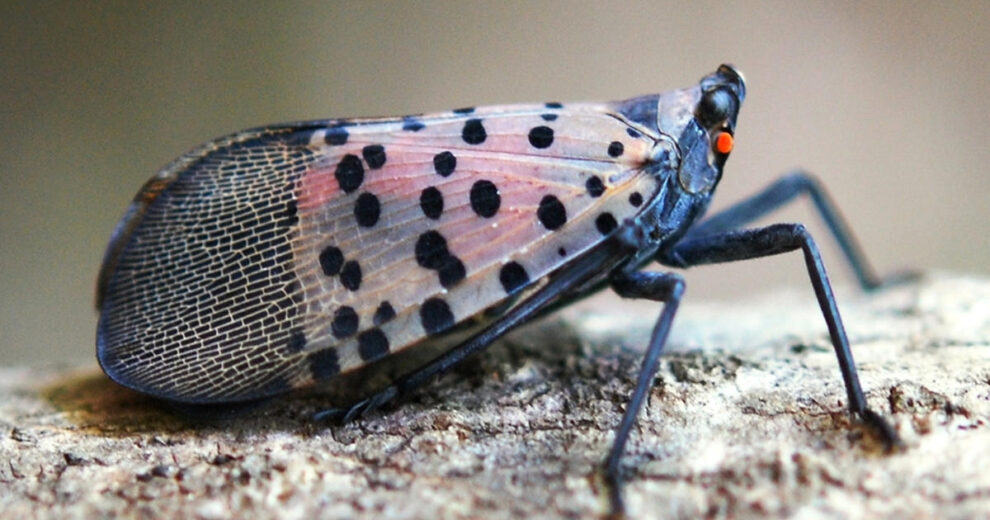A tiny pest known as the spotted lanternfly is creating a huge problem up and down the East Coast – and now it has been spotted in Illinois.
On Tuesday, the Illinois Department of Agriculture confirmed that the spotted lanternfly (Lycorma deliculata) has appeared for the first time in Illinois – though the department did not specify exactly where the spotting was.
The spotted lanternfly is an invasive plant hopper native to China. It was first spotted in southeast Pennsylvania in September 2014 and spread throughout the East Coast.
“It’s hard to tell exactly how they got here. The best we can say is that they came on imports and imported stone products,” Scott Schirmer of the Illinois Department of Agriculture told CBS 2’s Jim Williams and Marie Saavedra on Thursday. “So as a lot of these invasive species get into the United States from overseas, it gets on imports and materials and products moving into the country.”
The insects with their bright red underwings are visually striking at first glance. But they are no friends of ours.
“Being a non-native species, they don’t belong here,” Schirmer said. “There’s nothing that’s here that keeps them in check and keeps their populations down, so without having any of those biological controls in place, they can really run rampant, build their populations up, and live in populations that are almost overwhelming in the environment.”
Other states have set up quarantines – which forbids the moving of any spotted lanternfly egg, nymph, or adult – and regulates the movement of anything that could harbor the insect. This can be anything from firewood or a decorative grapevine to an RV, a barbecue grill, or a mobile fire pit, as the Pennsylvania Department of Agriculture explains.
Schirmer said it is too soon to know whether quarantines could be coming for spotted lanternflies in Illinois.
“We don’t have a lot of resolution on where this is – is this an isolated location as we know right now – or if there are additional locations elsewhere in Cook County or even throughout the state, we just don’t know right now,” he said. “So this offseason, we’re going to try and get some information through hopefully the public reports, and see if we can figure out where it is, what the extent of the infestation is, and then maybe make our management and regulatory decisions based on that information.”
Schirmer also reemphasized the guidance from officials in Illinois and every other state – if you see a spotted lanternfly, stomp it.
“Again, we want these to be reported, and we want to know where they’re being found. But yes, if we can engage the public to kill them, you know, we found the original report was a single one – and you know, that single one could be a gravid or pregnant female that could introduce an infestation to a new area, a new county, even potentially a new state,” he said. “So that’s what we’re asking is if you see it, you squash it, you take a snapshot of it, and then you report it to us so that we can look into it and follow up on it.”
Schirmer said the spotted lanternfly does not bite.
“They’ll do a little bit of piercing and sucking on plant bark, but they do not pose a threat to humans or pets or anything like that,” he said.
He added that the spotted lanternfly is similar to the emerald ash borer in that both are invasive species. But he said unlike the emerald ash borer, spotted lanternflies will not be killing trees en masse.
“We’re not going to have dying trees all over the place. It’s not going be that kind of insidious pest that kills trees. People are going to have to be aware that that’s not going to be an issue. It’s probably going to be more just the sheer numbers that they’re in, and encountering them out in their yards and in public areas,” he said.
Spotted lanternflies can feed on and kill around 70 types of trees and plants – including grapes, apples, hops, walnuts, and hardwood trees. CBS 2 in New York noted that there are now serious concerns about the vineyards in the winemaking regions of Long Island, the Hudson Valley, and the Finger Lakes in upstate New York.
But officials said in Illinois, they do not expect spotted lanternfly to become a crop-destroying pest.
Anyone who spots a spotted lanternfly should report it to lanternfly@illinois.edu. Photos are needed to verify a report and should be taken before killing the insects.
Once again, officials spotted lanternflies are to be stomped dead. Nymphs and adults should be squished, while egg masses should be scraped
Source : CBS News





































